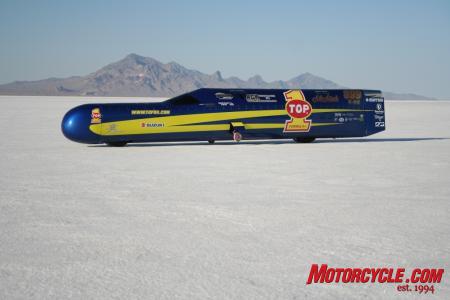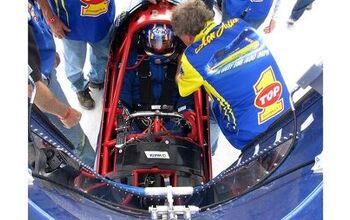Inside Rocky Robinson's Ack Attack Streamliner
The Ack Attack streamliner came to fruition after Mike Akatiff returned from an outing with his motorcycle club, the Mountaineers. Rather than a design room with engineers and bean counters crunching numbers and rattling off statistics, Mike and his riding pals sat around a campfire drinking beer and enjoying the camaraderie. One notable member missing from the get together was Sam Wheeler, who was off trying to break the world land speed record for motorcycles at the Bonneville Salt Flats.
Mike reckoned he could build just such a machine using a couple of Hayabusa engines and a pair of high-speed Mickey Thompson tires. His beer-toting buddies thought otherwise, and told him there was no way. That was all he needed to seal the deal. From an early age, Mike didn’t like being told he couldn’t do something. He had the resources and the time to give it a try; the rest as they say, is history.
When the bike was initially designed, the record stood at 322 mph. For all intents and purposes, the Ack Attack was designed with that number in mind, and what it would take to beat it. The approach was to do everything in excess. The carbon steel chassis was made with excessive bracing, tube diameter and wall thickness. As was later proven, the design was capable of withstanding high-speed crashes of over 300 mph. It did so twice, and on each occasion the driver walked away unharmed.
Breakaway points were built into the chassis behind the driver’s compartment. If it were to come apart in a crash, it would more than likely break away at these purpose-built weak points. Like speed boats, a parachute was attached to the rear of the compartment. The theory was should the crash be so violent that the machine were to break in two, the important half - the half the driver was strapped inside, would remain intact and continue on its way. As the chassis separated, the chute would automatically deploy and bring the front half to a stop quickly.
Mike remained true to his original thoughts, utilizing two Suzuki Hayabusa engines and a single, oversized turbo. Over the years the powerplant was refined and by 2008 an estimated 1,100 horsepower was realized. Overall weight with liquids and rider in place is 2,000 lbs. This is currently the largest and heaviest streamliner in its class, but to compensate for its bulk, the Ack Attack produces approximately twice as much power as Bub 7, and nearly three times as much as Sam Wheeler’s EZ Hook streamliner.
The rear wheel is driven by large, water cooled chains running on opposite sides. The dual rear brakes are also water-cooled at the rotor and caliper. The real braking however, takes place further back. A high-speed ribboned parachute handles the stopping duties while a larger, backup chute is available when needed. Lanyard length is critical as is the type of chute used. Ours are enclosed in cloth bags that when deployed, cause the chute to open more gradually, minimizing the initial “hit”.
Equally important is the location of the lanyard attachment. If the attachment is connected too high, it can cause downward force at the rear when the chute opens, making the front end light and unstable. If the attachment is too low, the rear of the bike can literally lift off the ground upon deployment. Great lengths were taken to insure that the Ack Attack’s lanyard attachment was in a neutral position. Mike had the bike hoisted into the air, dangling from its tail with the rider on board. The machine hung from the lanyard attachment positioned so that the bike was perpendicular to the ground. All guesswork was removed.
This machine was the first to break the 16 year standing record of Dave Campos at 322 mph. Chris Carr countered with a two-way average of 350 in the same year. Mechanical gremlins put an end to our attempt that year, but put a fire in Mike’s belly to return and take the record even higher. As mentioned before, this machine’s sole intent was to outrun the 322 mark, which it did so handily, before any of our competitors. The problem became what changes could be made to make it even faster. 350 mph is damned fast!
In 2006 our best pass was 349 mph, utilizing approximately 500 horsepower. We expected to produce 900 horsepower, but the turbo became clogged after the wire mesh from the exhaust bellows came loose and was inhaled into the turbine intake. A new exhaust was manufactured and an even larger turbocharger installed. We more than doubled the power output of the Ack Attack from its previous record run. Mike also decided to alter the shape of the bike, hoping for better aero-efficiency.
Before, the bike was six inches wide at the tail end. For 2007 tapered doors would be added bringing the rear of the bike to a point much like the wing of an airplane. This change alone would require significantly less horsepower to run at equal speed compared to the old design. It all sounded good in theory.
The 2007 attempt met with disaster. Even though we had more horsepower and were slipperier through the air, poor salt conditions saw to it that nobody upped the mark. The only good news was that the Ack Attack easily won top time of the meet. We also had second fastest time of the meet, and that was recorded with the Ack Attack tumbling head over heels through the kilo at an average of 278.540 mph!
Severe damage was done to the machine and a new body had to be made and mounted. A wide strip of metal was added running the entire length of the chassis to attach the upper and lower body sections, stiffening the bike in the process. The intercooler had to be modified to fit the new body, which for some reason wasn’t exactly the same shape as before, even though the same molds were used.
A new feature in 2008 was the use of dry ice. This voodoo magic gave me the willies every time the smoldering magma was dumped into the intercooler through a large funnel before every run. When the dry ice made contact with the water it would begin to percolate and boil. It was creepy being strapped into the cockpit on top of the intercooler because it actually felt like it was alive. The good news is it dropped the temperature about 20 percent, which meant we were able to run more boost and make more horsepower.
But what makes the Ack Attack special to me is that it still rides like a motorcycle - more so than my previous rides. It has handlebars and a twist throttle. The clutch lever is on the left and the gearshift is foot operated as is the rear brake. So what if it goes 150 in first gear and can light the tire in any of its six gears with just a twist of the wrist? I’ve heard it said many times - It’s not what you ride that matters. It’s that you ride.
Related Reading
Flat Out: Book Review
New motorcycle land speed record set
Bonneville's Blazing Bikes
More by Rocky Robinson

































Comments
Join the conversation